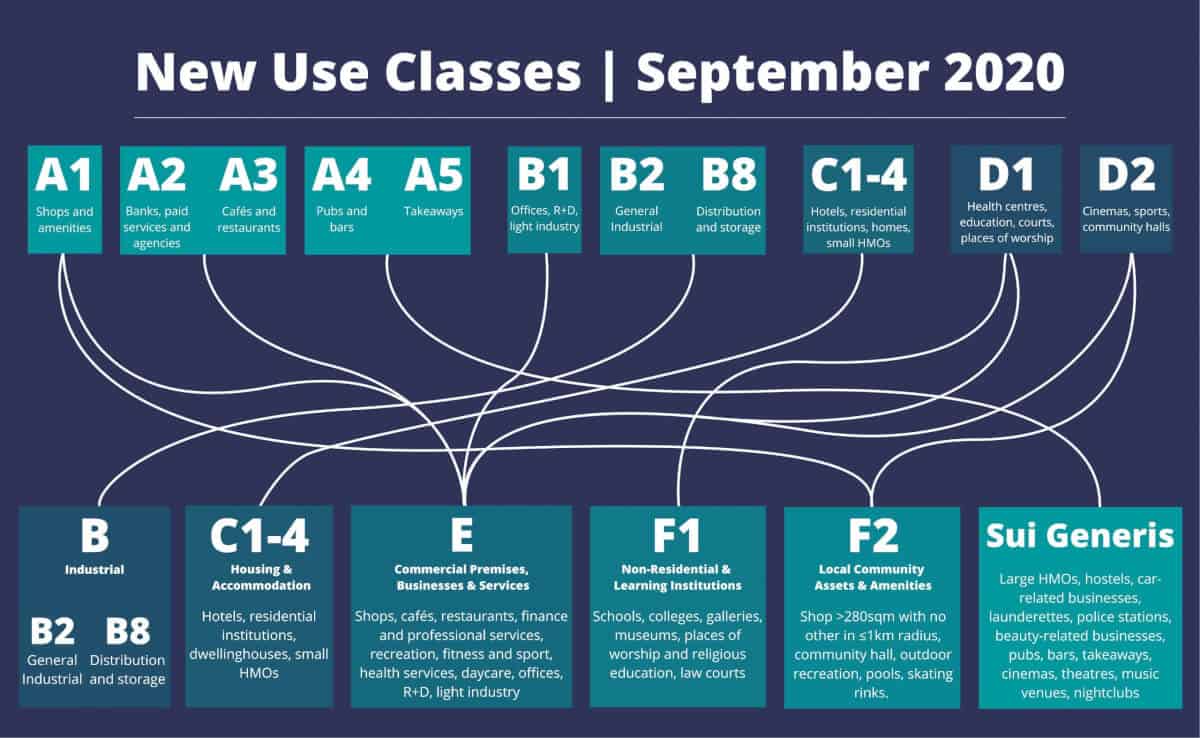Use Class Changes 2020 – Everything you need to know
The new use classes are designed to make it easier for similar types of buildings to be converted and to reduce the burden of paperwork on local councils to make redevelopment easier.
On the 21st July 2020 the government published the The Town and Country Planning (Use Classes) (Amendment) (England) Regulations 2020 which will come into force on the 1st September 2020. There will however, be a transitional period until 31st July 2021 where the former use classes will still apply to land and buildings for the purposes of the GPDO.
Use Class Changes: Main changes
The previous classes A and D have been got rid of, as has B1(a) in England, and three new classes have been introduced:
Use Class E – Commercial, Business and Service
This use class brings together:
- A1(shops)
- A2 (financial and professional services)
- A3 (restaurants and cafes)
- B1 (business)
- parts of classes D1 (non-residential institutions) and
- D2 (assembly and leisure)
The previous classes have been brought together into a single use class to allow for changes of use without the need of planning permission. Shops and facilities considered important to the local community have been placed into Use Class F2.
Use Class F1 – Learning and non-residential institutions
This brings together some elements of Use Class D1 namely, schools and colleges etc., galleries and museums, public libraries, public hall or exhibition hall and churches etc.


Use Class F2 – Local community uses
This use class is designed to protect local community assets and include shops smaller than 280 m² and without another shop in a 1km radius, a hall or meeting place use by the local community (previously us class D1), outdoor sport or recreation locations (was D2(e) use class) and swimming pools or skating rinks (was D2(f) use class)
The New Use Class E: Commercial, Business and Service
Anything from a bank to a bowling alley will be covered by Class E, and the owners of won’t have to get planning permission to change the use of their building – they may of course need planning permission for any architectural changes you need.
Not all shops or high street businesses will become E, however, as mentioned above, small country shops that sell food and essentials at least 1km from the closest similar shop will now be part of the new F2 community use.
Pubs and bars (previously A4), takeaways (A5), cinemas and live music venues (D2) will go into the catch-all Sui Generis classification.
Article 4 directions blocking current permitted development rights – for instance A1 (shops) to A3 (restaurants and cafés) – will still apply even though the A classes will no longer exist.
Why are there new use class changes?
As of September 2020, there will be changes in the way building use is classified in an attempt by the government to face the changing uses of the high street in recent years – something that Covid-19 will undoubtedly accelerate.
These changes in the use classes order replace quite a bit of what Permitted Development Rights is supposed to do. Politically, this might be seen as an attempt to let the market decide the future of the high street given the rise of online shopping and click-and-collect services.

The idea is to incorporate greater flexibility into how buildings are used to enable them to adapt to how people’s leisure and shopping habits are evolving. Services like banks and hardware stores, for example, are closing all across the country (whether they should be is another matter) and leisure uses are growing – there are more beauty salons and coffee shops on our high streets than ever before. As a practical measure, re-classing these uses cuts down on bureaucracy and makes life a lot easier for those that want to set up a business, or landlords that want to switch the use of their assets.

The Takeaway
This new class allows for a mix of uses to reflect changing retail and business models. It therefore recognises that a building may be used in a number of different ways and allows these uses to change without requiring planning permission.
Bringing these uses together and allowing movement between them will give businesses greater freedom to adapt to changing circumstances and to respond more quickly to the needs of their communities.
However, it remains to be seen how these changes filter though, especially given councils’ need to retain vibrancy and use of the high street.
Make your conversion easier with our use class changes experts
With the huge changes to the economy and our high streets set to come in the next few years, this flexibility is to be welcomed. At Lapworth Architects we’ve worked on hundreds of Change of Use applications, and have adapted to the new changes to help business owners all across the West Midlands. If you’ve got any questions, don’t hesitate to get in contact via the number at the top of the page, talk to us on our live chat or drop us a message in the footer down below. Let’s get your project started!
